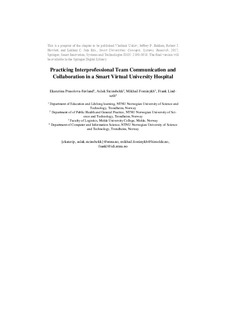| dc.contributor.author | Prasolova-Førland, Ekaterina | |
| dc.contributor.author | Steinsbekk, Aslak | |
| dc.contributor.author | Fominykh, Mikhail | |
| dc.contributor.author | Lindseth, Frank | |
| dc.date.accessioned | 2019-09-19T11:26:38Z | |
| dc.date.available | 2019-09-19T11:26:38Z | |
| dc.date.created | 2018-09-13T12:44:52Z | |
| dc.date.issued | 2018 | |
| dc.identifier.isbn | 978-3-319-59454-5 | |
| dc.identifier.uri | http://hdl.handle.net/11250/2617658 | |
| dc.description.abstract | A smart university must utilize different technical solutions to offer its students varied and innovative learning environments optimizing the core learning activities. Contact with patients is at the core of medical and health care education, often taking place at a university hospital. However, students from one profession seldom get the chance to practice in a hospital setting with students from other professions, and they seldom see the whole patient trajectory during clinical practice. Establishing a smart virtual university hospital mirroring a real life hospital can prepare students for direct patient contact such as practice placement and clinical rotation, and thus optimize and sometimes also increase their time on task. Such a virtual arena will support student learning by providing adaptive and flexible solutions for practicing a variety of clinical situations at the students’ own pace. We present a framework for a smart virtual university hospital as well as our experiences when it comes to developing and testing solutions for training interprofessional team communication and collaboration. In the main part of the work reported here, medicine and nursing students worked in groups with the clinical scenarios in a virtual hospital using desktop PCs alone and with virtual reality goggles. In the evaluation, it was found that all the students agreed that they had learned about the value of clear communication, which was the main learning outcome. Using virtual reality goggles, almost all the students reported that they felt more engaged into the situation than using desktop PCs alone. At the same time, most also reported ‘cyber sickness’. We conclude that a smart virtual university hospital is a feasible alternative for collaborative interprofessional learning. Keywords: smart virtual university hospital, virtual reality, medical training, collaborative learning, virtual operating room, educational role-play | nb_NO |
| dc.language.iso | eng | nb_NO |
| dc.publisher | Springer Verlag | nb_NO |
| dc.relation.ispartof | Smart universities : concepts, systems, and technologies | |
| dc.title | Practicing interprofessional team communication and collaboration in a smart virtual university hospital | nb_NO |
| dc.type | Chapter | nb_NO |
| dc.description.version | acceptedVersion | nb_NO |
| dc.source.pagenumber | 191-224 | nb_NO |
| dc.identifier.doi | 10.1007/978-3-319-59454-5_7 | |
| dc.identifier.cristin | 1609164 | |
| dc.description.localcode | The final authenticated version is available online at: https://doi.org/10.1007/978-3-319-59454-5_7 | nb_NO |
| cristin.unitcode | 194,67,70,0 | |
| cristin.unitcode | 194,65,20,0 | |
| cristin.unitcode | 194,63,10,0 | |
| cristin.unitname | Institutt for pedagogikk og livslang læring | |
| cristin.unitname | Institutt for samfunnsmedisin og sykepleie | |
| cristin.unitname | Institutt for datateknologi og informatikk | |
| cristin.ispublished | true | |
| cristin.qualitycode | 1 | |
